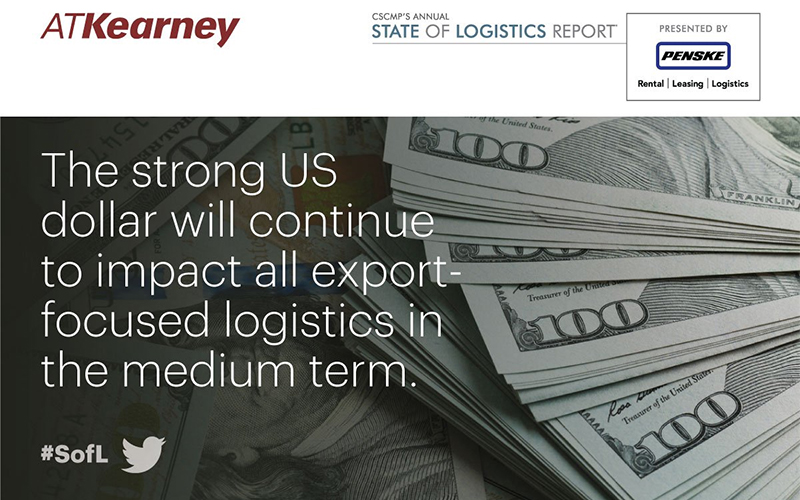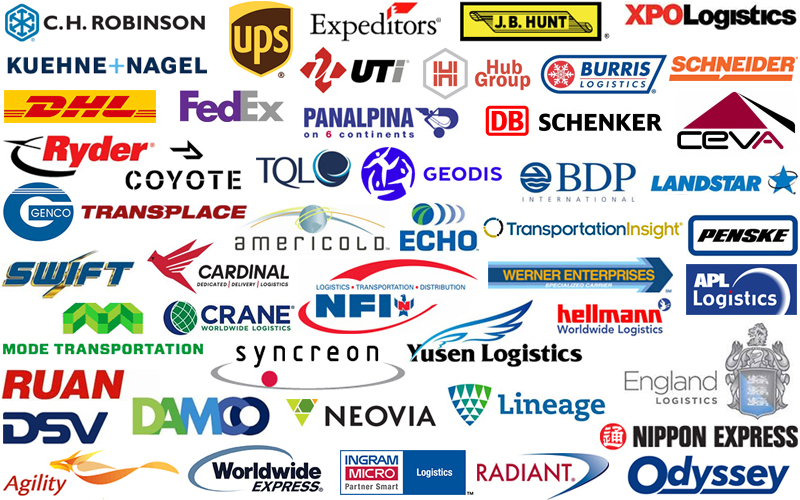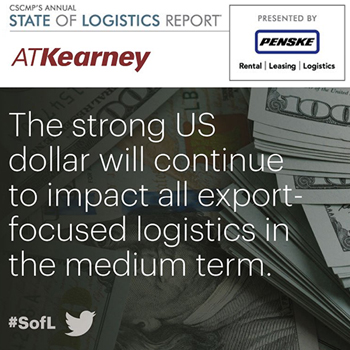State of Logistics 2016: US Business Logistics Costs Slow Considerably with 2.6% Growth

It’s a buyer’s market for business logistics right now, but that is a fleeting condition subject to rapidly changing conditions in the $1.408 trillion U.S. freight sector, based on data in the 27th Annual State of Logistics Report.
The report is sponsored by the Council of Supply Chain Management Professionals (CSCMP).
For the first time, CSCMP collaborated with global strategic management consulting firm, A.T. Kearney, as the new author and researcher.
Penske Logistics continued in its longstanding role as top supporter of the report.
The report reveals total U.S. business logistics costs rose to $1.48 trillion in 2015, a 2.6 percent increase from the previous year. That represents a considerable slowdown from previous years.
“Today, the logistics system is sound,” the SoL report concludes. “Desired services and features are generally available, and a system designed for cost efficiency is delivering pricing favorable to shippers. However, gaps in infrastructure and accelerating trends for speed will increasingly pressure a system that was not designed for e-commerce-driven ‘last mile, last minute.’”
Business logisticians can give themselves a pat on the back for driving down total U.S. business logistics costs (USBLC) six basis points from the previous year. USBLC amounted to $2.15 trillion last year, or a scant 7.85 percent of Gross Domestic Product. That was compared to USBLC being 7.91 percent of GDP in 2014. The all-time low was during the Great Recession in 2009 when USBLC was 7.37 percent of GDP.
“Supply chain transparency continues to grow in importance for shippers and third-party logistics providers,” said Penske Logistics President Marc Althen.
“This is driving significant technological change for 3PLs and shippers alike as they collaborate and share more real-time information to enable data-driven business decisions and meet the growing needs of consumers.”
“This highly anticipated report contains the statistics and industry insights that will not only help our members do their jobs better, but also better prepare them for the business demands ahead,” said Rick Blasgen, president and CEO of CSCMP.
The report includes a focused narrative on the economic environment impacting logistics; insights from interviews with industry leaders, including shippers, carriers, and analysts; a spotlight on relevant trends; and a strategic point of view on the state of the industry.
“It is a dynamic time for the logistics sector - macro economy, new business models, technology,” Sean Monahan, A.T. Kearney partner and co-author of the 2016 State of Logistics Report said. “We are pleased to support CSCMP in the development of this report.”
Among the report’s key conclusions is the logistics industry is entering a new era. The report predicts over the next decade, the logistics industry will face “disruptive forces,” including technology and operational constraints that threaten to fundamentally change the rules of the game.
It may already be starting. Motor carriers are experiencing rate weaknesses, especially in the $278 billion truckload market, as temporary overcapacity has given shippers some pricing power. The report concluded that TL rates and demand for transportation are “soft, and continue to fall.”
While this is occurring, the TL sector copes with nearly 100 percent driver turnover as the truck driver shortage continues. “Despite softening demand and slower rates, competition for drivers remains intense,” the report concludes.
There are bright sports for asset providers, however. The $82.2 billion parcel and express sector, fueled by double-digit growth in B2C online commerce, continues to grow. Its main drivers are the “explosion” of B2C e-commerce and omni-channel retail, the report says.
On the other hand, water shipping is in “flux,” as containerized shipping is experiencing significant overcapacity. Like truckload, this is creating a “favorable rate environment” for U.S. shippers, the report concludes.
The $67 billion air freight sector continues to be in the dumps. While the industry copes with overcapacity and falling rates, demand for airfreight services remains “sluggish” due to economic uncertainty. At the same time, the report says, overcapacity is being exacerbated by a shift to wide-body aircrafts.
The $29.5 billion pipeline industry is catching up with demand as U.S. oil and gas production has surged over the past decade. U.S. pipeline investment will account for three-quarters of all planned capital investment in transportation modes, the report says.
Another sector experiencing woes is the $80.7 billion railroad industry due to sharp drops in demand. A steep decline in coal traffic and crude by rail, macroeconomic weakness, and a pause in the growth of intermodal traffic resulted in overall rail volume reduction, the report concluded.
Meanwhile, technology continues to play a key role in the evolution of the 3PL market. At $196 billion, the US 3PL market now accounts for 11 percent of US logistics spend. IT has risen by roughly 7.5 percent annually from 2009 and 2014. But in a sign of things to come, that growth is expected to be 5.6 percent over the next four years through 2018.
CSCMP’s State of Logistics Report is available at the CSCMP Website.
Related: 2015 Top 50 Global & Domestic U.S. Third-Party Logistics Providers

Article Topics
CSCMP News & Resources
60 Seconds with Robert Martichenko of American Logistics Aid Network Sustainability Efforts Continue to Ramp Up, Research Finds Today’s modern shipper-3PL relationships focus on collaborative growth and improvement BlueGrace executive assesses various market trends and themes at CSCMP EDGE CSCMP EGDE panel examines the impact of supply chain volatility on costs and operations Top Target supply chain executive McCarthy provides an inside look at the company’s supply chain and logistics operations 2023 State of Logistics Report: Great logistics reset More CSCMPLatest in Transportation
FedEx Announces Plans to Shut Down Four Facilities The Two Most Important Factors in Last-Mile Delivery Most Companies Unprepared For Supply Chain Emergency Baltimore Bridge Collapse: Impact on Freight Navigating Amazon Logistics’ Growth Shakes Up Shipping Industry in 2023 Nissan Channels Tesla With Its Latest Manufacturing Process Why are Diesel Prices Climbing Back Over $4 a Gallon? More Transportation











